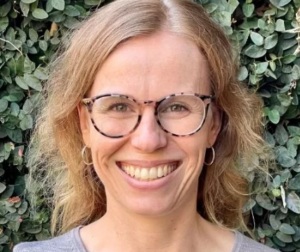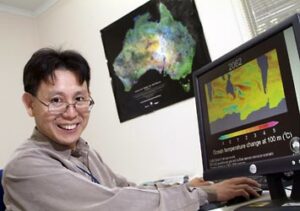Can crisis tip us into an ecologically sane civilization? UK Think tank report author Laurie Laybourn on a future where disasters ripple across the world. Then let’s get away – to Antarctica. Why did sea ice crash around that frozen continent? Increasing El Nino events may drive global sea levels higher. Australian scientist Adriaan Purich shares big changes at the South Pole.
Listen to or download this Radio Ecoshock show in CD Quality (57 MB) or Lo-Fi (14 MB)
Radio Ecoshock is listener-supported journalism. There are bills to pay – especially when large-file downloads are free to people around the world. We keep it advertising free, no pop-ups or requests for your personal information. We don’t re-sell our listeners. That means it is up to you to help keep this going. If you can spare a donation of any amount, please use this helpful page. Thank you. Alex Smith.
====================================
LAURIE LAYBOURN – AVOIDING THE CLIMATE DOOM LOOP
Two things I find most annoying in climate speak: talking about 1.5 degrees C of warming in the future as though that is still possible – and – assuming humans will build back no matter how many times disasters strike. A new UK think tank report tackles both. They find a looming risk of falling into a climate “doom loop”.
The researchers come from two well-known quarters, the Institute for Public Policy Research (IPPR) and Chatham House, both in the UK. They question whether the grand transformation of energy, consumption, almost everything, can actually happen in a warmer world. Stalling now we are, could mean we fail, become ruled by a continuing stream of disasters.
One of the thought-leaders in this process is Laurie Laybourn. Laurie is a Visiting Fellow at both thinktanks as well as the Global Systems Institute at the University of Exeter. He appears often in European publications, TV and radio. Laurie directs the Cohort 2040 project.

Listen to or download this 30 minute interview with Laurie Laybourn in CD Quality or Lo-Fi
The new paper, with Henry Throp and Suzannah Sherman of Chatham House, is titled “1.5°C – dead or alive? The risks to transformational change from reaching and breaching the Paris Agreement goal.” That sounds institutional, but the subtitle nails it: “The historical failure to sufficiently tackle the climate and ecological crisis could create consequences that challenge the ability of societies to tackle the root causes of this crisis.”
We start with an amazing factoid. Loretta Hieber-Girardet at the United Nations Office of Disaster Risk Reduction was presenting at a panel Laurie moderated last June. It was part of London Climate Action Week. Loretta said:
“by 2030, global disasters could increase by 40%. This amounts to 540 disasters every year, or more than 1.5 per day.”
“We are seeing disaster impacts cascading from one system to another, and when that happens pre-existing vulnerabilities amplify their impacts.”
– Loretta Hieber-Girardet, United Nations
We need to stop thinking about just direct impacts, and not indirect. Loretta talks about the examples in Bangladesh, a disaster can lead to long-term migration, early marriage, and other problems not caused directly by the flood or heat wave.
That is more than the news or any of us can absorb, – and just seven years away according to the U.N. What do you think it would be like, living in such a disastrous time?
SERIOUS LOW IMPACT CLIMATE CHANGES
Surprisingly, Loretta also warned, quote: “where we’re really seeing the greatest impact is through these high frequency low intensity but very, very regular events at the community and the local level.” So it is not just the big disasters that make the news that count, but repeated changes around us. Or as Laurie Laybourn says: “…we’re not factoring in the cascading risks to societies. It’s not just the big city-smashing storms we should be concerned about, it’s the consequences that ripple through our globalised systems”.
Take an example from Nature. Experts tell us fires are part of forest ecology in Western North America. But Canadian fire expert Michael Flannigan told us two cases where the forest does not return. The first is a fire so hot the soil is sterilized. The second is when wildfires return to the same place within five years, killing off young trees before they seed. Could human civilization be the same: rebuilding after one disaster, but unable to continue after repeated hits?
Also this: extreme events, not seen before, can damage the people’s sense of immunity. A whole generation no longer trusts their environment, their city, or their homes. Some will have Post-Traumatic Stress Disorder (PTSD). Even developed countries have not developed treatment for a whole population traumatized. As we break the climate, is anyone looking into mass trauma care?
In recent years, many countries worst hit by big disasters were least able to afford to do much about them. Pakistan endured major floods but the country’s finances are on life-support from the World Bank. We recently heard about extreme heat and drought in Argentina, another nation close to bankruptcy. Will failure to recover affect the world economy, and people in developed nations?
If civilization is pummeled by climate disasters beyond control, what does that mean? Should we give up dreams of green transformation? Should we prepare for a new Medieval Age?
It is not as though climate disasters arrive in an otherwise normal world. The UK recently counted another 138,000 new COVID-19 infections in single day. The American Center for Disease Control just admitted about 1 in 5 people infected with COVID have lasting effects. Millions have long-COVID. Will this not weaken our ability to transform away from the fossil-powered economy?
IT IS NOT JUST THE COST OF DAMAGING HUMAN INFRASTRUCTURE
More hidden after the super-storm or floods: even if human houses are rebuilt and roads restored, there will still be damage to natural systems. These are seldom if ever restored or even helped. Species already at risk may disappear. New invasive species, from insects to poisonous plants, may take over. After a repeat wildfire wipes out new growth of forests, the whole region might convert to grasslands. That is a completely different carbon balance for the atmosphere, but also for every range of creatures formerly and newly living there.
Could those repeated damages to the natural world also weaken humans and our ability to respond? Say, if the mosquito carrying dengue and other tropical fevers moves north, that would weaken a whole population and divert economic resources. If the dam on a glacial lake breaks, the floods may wipe out parts of cities for hundreds of miles below. That is the disaster. But a steady constant flow of water has been lost, possibly making agriculture impossible, leading to starvation and migration.
THE HIDDEN MIGRATION
When disaster wipes out significant infrastructure, and frightens people badly, a percentage of those fleeing never return. This happened in America following Hurricane Katrina. Untold thousands of people, many African America, fled not just to nearby Houston, but to Denver, to Tennessee, all over the country. Many did not return.
The loss of humans after a disaster has side-effects, like business closing or jobs lost as key people decide to reestablish elsewhere. Some skills are lost. Entire neighborhoods may stay empty or blighted. In some countries, a slum may appear on damage land, and no-one tracks the health care costs of any toxic materials remaining.
All this adds up to a lesser factor of climate-driven disasters: human migration could weaken capability to prepare for the next disaster. Read more about this story in this Guardian newspaper article: “World risks descending into a climate ‘doom loop’, warn thinktanks”,
THE UNITED NATIONS DEFINITION OF “DISASTER”
DISASTER: “A serious disruption of the functioning of a community or a society at any scale due to hazardous events interacting with conditions of exposure, vulnerability and capacity, leading to one or more of the following: human, material, economic and environmental losses and impacts.”
Disaster impact is the total effect, including negative effects (e.g., economic losses) and positive effects (e.g., economic gains), of a hazardous event or a disaster. The term includes economic, human and environmental impacts, and may include death, injuries, disease and other negative effects on human physical, mental and social well-being.
THE U.N. HAS AN AGREEMENT ON DISASTER: SENDAI FRAMEWORK
Sendai Framework for Disaster Risk Reduction 2015-2030
SEE ALSO: BREACHING 1.5…
“Breaching the 1.5°C target could be used as an excuse to delay climate action” February 21, 2023 published on Inside Track, the Green Alliance blog. The post is by Joseph Evans, researcher at IPPR on the Cohort 2040 project.
Breaching the 1.5°C target could be used as an excuse to delay climate action
====================================
STRANGE NEWS FROM ANTARCTICA
– DR. ARIAAN PURICH
Scientists and weather forecasters are worried about the next El Nino. That is when Earth jumps up in heating, like on 1997/98 and 2012, the record years. Did you know they also predict more El Nino’s than we’ve seen, and stronger extremes. That will play out in heat waves, wildfires, droughts and big storms – but there is another hidden place of impacts: Antarctica. From those massive Polar glaciers to giant ice shelves breaking off, expect more sea level rise – sooner than they told you. Naturally, the neighbors in Australia are looking into it.
Our guest Dr. Ariaan Purich is in the thick of Australian research about the Southern Ocean and Antarctica. At Monash University in Melbourne, she is a postdoctoral research fellow at School of Earth Atmosphere and Environment. She is also part of the Australian Research Council’s special initiative called Securing Antarctica’s Environmental Future or SAEF. Ariaan is co-author of a new paper finding El Nino events could change Antarctic sea ice and speed sea level rise around the world.

Listen to or download this 28 minute interview with Ariaan Purich in CD Quality or Lo-Fi
The paper we discuss most in this interview was published February 20, 2023 in Nature: “Antarctic shelf ocean warming and sea ice melt affected by projected El Niño changes.”
MY TAKE ON THIS PAPER
Climate-driven changes to the big ENSO see-saw of heating and cooling ocean waters is expected to (a) slow down Antarctic sea ice loss despite global warming and (b) to push more warm water under the big ice shelves that act as brakes against the flow of glaciers into the sea. That means we may see sea ice seeming to be relatively stable, or less drastic than this year, but that is deceptive, because more El Nino events will speed up ice loss from the continent, raising sea levels higher and faster than previously predicted.
Most media is in the Northern Hemisphere. Most humans live there. Hardly anyone spends time on the rough waves of the Southern Ocean, so we don’t hear much about it. Yet some scientists think the Southern Ocean is a huge factor in the future world climate.
Ariaan was part of a team of scientists trying to understand the future of sea ice and ice shelves around Antarctica. They looked at another driver: the ocean heat system known as El Nino or La Nina, technically called ENSO. The paper, published February 20, 2023, is titled: “Antarctic shelf ocean warming and sea ice melt affected by projected El Niño changes”.
Starting in 2014, Dr. Wenju Cai of the government science agency CISRO first published his findings of “Increasing frequency of extreme El Niño events due to greenhouse warming”. Simply put, Dr. Cai is a power-house researcher in this field, publishing for the past 25 years. He led this recent study.

Years ago, in 2014, Dr. Cai predicted El Nino will appear twice as often than in the last 40 years, as the world warms. See the paper: “Increasing frequency of extreme El Niño events due to greenhouse warming”.
CRASHING SEA ICE AROUND THE SOUTH POLE
Why don’t we start with Antarctic sea ice. It is in the news. CNN reports “90% of ice around Antarctica has disappeared in less than a decade”. See too this Guardian article, which quotes our guest Ariaan Purich. She says Antarctic sea ice is at the lowest level ever recorded. Just imagine the loss of reflection of solar energy, replaced by the dark absorbing sea. This must affect the Earth energy imbalance (EEI) – which adds more warming.
SEE ALSO:
Billions of Tonnes of Ice Lost From Antarctic Ice Sheet
University Of Leeds 20 March 2023
Scientists have calculated that the fastest changing Antarctic region – the Amundsen Sea Embayment – has lost more than 3,000 billion tonnes of ice over a 25-year period. They say: “So much water is held in the snow and ice, that if it were to all to drain into the sea, global sea levels could increase by more than one metre.“
AND THIS KEY PAPER: STRONGER EL NINO AND LA NINA COMING BY 2030’S
A modelling study last year suggested stronger El Niño and La Niña events due to global heating may be detectable in the eastern Pacific Ocean by 2030, decades earlier than previously expected.
“Global heating to drive stronger La Niña and El Niño events by 2030, researchers say”
Guardian November 16, 2022 by Donna Lu
“New modelling suggests climate change-driven variability will be detectable decades earlier than previously expected.” Scientists knew that eventually the heating signal of global warming would amplify the ENSO events. But earlier research suggested those climate-driven changes would not appear until about 2070. Now with a November 2022 paper with Tao Geng, Wenju Cai moves those changes closer, to the 2030’s. Given the huge impacts of El Nino in creating hot years, and La Nina driving storms into North America, it is terrible to imaging those big weather drivers on steroids, due to climate change.
That paper is: “Emergence of changing Central-Pacific and Eastern-Pacific El Niño-Southern Oscillation in a warming climate”, It is Open Access – free for anyone to read.
—————————————————–
Let your mind stretch around the planet. Become a global citizen, not just in humanity, but within the miracle web of life.
I’m Alex Smith. Thank you for listening, and caring about our world.
Why are experts talking about doom scenarios a decade or so away, & avoiding more immediate threats? An imminent worry must be of major adverse effects from the predicted El Niño (some say Super El Niño) upon the Indian Monsoon. Historically this results in an adverse shortfall of the monsoon, but with weather extremes flip-flopping, unprecedented flooding also can’t be ruled out.
India is already suffering from extremes of heat & drought, with the associated inability to sow crops & prospects of later crop failure. The effects for the Sub-Continent could be catastrophic for 2023/2024 with Pakistan already a basket case verging upon becoming a failed (nuclear-armed ! ) nation state.
Great episode as always Alex
Why does Laurie Laybourn think we can avoid collapse. We are ALREADY IN collapse. And it’s accelerating. Places like Pakistan & New Zealand & Australia & California which were just recently flooded will never recover & are spiralling down right now in to chaos.
Insurance sector is bailing & on the verge of collapse too to compound this acceleration.
No need to worry about climate collapse. Nuclear war will render humanity (and most species) extinct sooner rather than later… unless the warmongering US neocons (who 100% provoked the Ukraine conflict and are now baiting China over Taiwan) are taken down. BTW, the US military are are single entity with largest fossil fuel emissions in the world.
The world of birds here is a source of endless wonder.